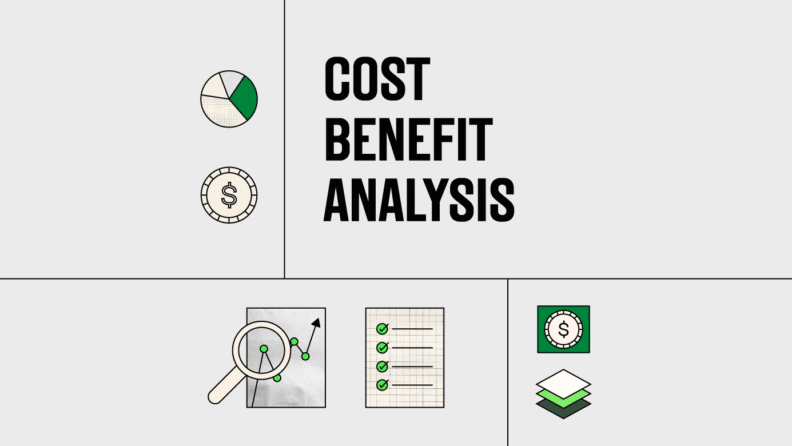Business owners have a lot of spending decisions to make. While gut feelings may have worked in the beginning, the best way to figure out if an investment is going to pan out is to run a cost benefit analysis.
What is a Cost Benefit Analysis?
Cost benefit analysis is a systematic approach to evaluating the pros and cons of a given decision, project, or investment. It takes a hard look at the total impact—and total costs—of a given decision and draws conclusions on the best course of action, based on the data.
For instance, a business may be considering expanding into a second location, which they estimate will cost:
- $125,000 in initial build-out costs
- $105,000 per year in future costs for ongoing labor and overhead
These estimates cover the hard costs of this decision. The “benefits” portion would involve running some financial forecasting to predict estimated revenue and profit from that location.
What is the Benefit-Cost Ratio?
The benefit-cost ratio (BCR) is a feasibility indicator showing the direct relationship between the estimated costs and benefits of a proposed investment or project.
A BCR of 1.0 indicates that the benefits exactly match the expenditures (ex. $10,000 in benefits for $10,000 in costs), while anything greater than 1.0 indicates a project with a positive net present value.
A BCR of less than 1.0 indicates a negative net present value (and is a good signal that the project isn’t worth considering).
A “good” BCR is highly dependent on industry, project scale, and other factors like time required to realize the investment’s gains. Fortunately, BCR makes it easier to compare multiple projects or investments because it standardizes reporting across multiple project types and capital outlay levels.
Why is Cost Benefit Analysis Important?
Cost benefit analysis is important, first and foremost, because it allows businesses to evaluate the desirability of opportunities based on objective data.
There’s more. Cost benefit analysis:
- Enables systematic decision-making processes based on estimated financial outcomes
- Optimizes resource allocation
- Enables comparative analysis
- Improves transparency and accountability within the organization
- Allows for a better risk management analysis process
- Improves long-term planning
One crucial—and often overlooked—aspect is comparative cost analysis.
Comparative Cost Analysis
This practice allows a business to evaluate each project compared to another investment or way of doing things, bringing opportunity cost into the equation.
For instance, if a business is considering spending $125,000 to open a new location, the business could then run a cost benefit analysis on the effectiveness of spending that same $125,000 differently—say, on advertising and capital improvements for the existing location.
By then comparing the results, they could make the most optimal investment decision based on anticipated business outcomes. I’ve included an example of a comparative cost analysis for a single decision later in this article.
When To Do A Cost Benefit Analysis
Benefit and cost analysis is a systematic process that should be completed whenever significant projects or initiatives are being considered. The main operational situations where it’s most often used are:
- Before a major investment
- When selecting projects to pursue
- When conducting quarterly resource allocation planning
- Before a major acquisition or merger
- When introducing a new product or service
In reality, conducting cost benefit analyses is a vital element of being a strategic financial operator, and can be beneficial whenever a decision needs to be made that involves significant resources, risks, or potential impact to stakeholders.
If becoming a strategic CFO is your intended career path, it’d be best to familiarize yourself with how to complete these efficiently and effectively.
Be careful not to use them too often, though. If you start running comparative analyses on things like the best type of coffee to buy for the office, you’ll find yourself on a one-way train to Ignore-ville.
How to Complete a Cost Benefit Analysis
To run a cost benefit analysis, follow these steps.
1. Establish a Framework
The best way to start is to define your goals, objectives, and KPIs for a given project. Get clear on:
- What success looks like,
- How you’ll measure that success, and
- The financial impact of that success—more on that in step 3.
2. Get Specific with Each Cost and Benefit
Next, identify each type of cost and benefit—and seek to go beyond the obvious.
For costs, you might have:
- Direct costs (materials, labor, inventory, etc.)
- Indirect costs (utilities, rent, etc.)
- Intangible costs (changes in productivity levels, negative effects on customer satisfaction, etc.)
- Opportunity costs (return on investment from other assets you could’ve invested this money into, or the interest amount you’d earn on cash savings)
For benefits, the list is similar:
- Direct benefits (increased revenue from a new project or location)
- Indirect benefits (increased brand awareness)
- Intangible benefits (improved customer experience or company morale)
- Competitive benefits (expanded business reach)
It’s important to think about all the potential costs and benefits before calculating the dollar values associated with each.
3. Estimate Monetary Values for Each Cost and Benefit
Now, it’s time to put hard numbers on each of your project costs and benefits. Expected costs and benefits should, wherever possible, be compared in a common unit of measurement.
For most business decisions, costs and expected benefits can be measured in actual dollars—if benefits are less tangible, such as increased efficiency, the best thing to do would be to take steps to reasonably quantify them, ie estimated time savings x hourly cost of that person’s time.
Certain types of accounting software and EPM software solutions have features that can be used to estimate the effects of less tangible costs and benefits.
4. Compare Costs and Benefits Using BCR
Now you can tally up all the costs and benefits of a project to calculate the benefit-cost ratio. If the BCR is positive (over 1.0), the project has a solid business case for moving forward.
That doesn’t mean it’s an optimal decision, though.
5. Run Cost Benefit Analysis for Alternatives
Now it’s time to play the field, financially speaking.
To evaluate all your options, you should run a similar cost benefit analysis on alternatives that you’re considering. Then, compare each BCR to determine the optimal allocation of your resources.
Cost Benefit Analysis Example
It can be difficult to consider the smaller—but still impactful—investments that this kind of analysis is useful for, so I decided to outline a situation you probably wouldn’t have thought to do a cost benefit analysis for.
Example: Installing LED Lighting in Company Facilities
A company is weighing the pros and cons of refitting existing facilities with high-efficiency LED lighting. They’re comparing two options:
- Make no changes
- Replace the existing bulbs with high-efficiency LED lighting
The firm decides to use a 5-year time frame to compare the outcomes of this project.
| Scenario 1 | Scenario 2 | |
| Benefits | No upfront investment required: $15,000 (savings)Annual expected yield on cash saved from initial investment: $500 | Annual PR benefits from going green: $2,000 Annual electricity savings: $9,000 |
| Total Benefit Value | $17,500 over 5 years | $55,000 over 5 years |
| Costs | Initial investment: $0Annual electricity costs: $15,000Annual maintenance costs: $2,000 | Initial investment: $20,000Annual electricity costs: $6,000Annual maintenance costs: $2,000 |
| Total Costs | $17,000 over 5 years | $40,000 over 5 years |
| Benefit-Cost Ratio | 0.205 | 1.375 |
With this analysis, it becomes clear that Scenario 2 is the better option. Despite higher upfront costs, the total benefit is over 6.5 times greater.
Advantages of Using Cost Benefit Analysis
These are the primary advantages of running a cost-benefit analysis, from a business perspective.
- Data-driven decision-making: cost benefit analysis eliminates a lot of the “gut decisions” that may be made in business, focusing instead on a data-driven approach. Identifying hard numbers for both tangible and intangible benefits and costs can help decision makers achieve better results.
- Uncovers hidden costs and benefits: Some costs and benefits aren’t obvious right away—like a PR boost from making an environmentally-friendly change, or temporarily disrupted productivity due to implementing a new system. Thorough cost benefit analysis helps with quantifying these hidden effects.
- Allows for rigorous comparative analysis: It’s often challenging to compare different opportunities or projects, particularly if they involve different levels of capital outlay and/or different operational effects. With cost benefit analysis—and the benefit-cost ratio in particular—independent analysis can be synthesized to more accurately compare all your options.
Limitations of Cost Benefit Analysis
I must admit, though, cost benefit is not the end-all-be-all. There are some limitations, like:
- Difficulty estimating intangibles: Inaccurate data can skew your results, and cost benefit analysis often involves some guesswork when it comes to intangibles.
- Limited efficacy for long-term projects: For long-term projects, factors like opportunity cost, inflation and external variables can have a significant impact on results—as can inaccurate forecasting. Cost benefit analysis is best suited to short- and mid-length projects.
Types of Cost Benefit Analysis
These are the fundamental methodologies associated with cost benefit analysis.
Benefit-Cost Ratio (BCR)
Unless you skipped down to this section, you’re familiar with this one by now. BCR is a simple ratio between total benefits and costs, with a value of over 1.0 indicating a positive business outcome.
Net Present Value (NPV)
Net present value calculates the present value of future cash flows, minus the initial investment. Similarly to a discounted cash flow model, NPV allows you to better gauge opportunity cost by applying a discount rate to account for the return on capital that could be achieved elsewhere if the investment is not made.
Internal Rate of Return (IRR)
Also known as the discount rate, IRR represents the discount rate at which the net present value of an investment equals zero. It’s the rate of return required to have the present value of cash inflows equal the present value of cash outflows.
In non-jargon, IRR tells you the viability of an investment after bringing time into the picture. The higher an IRR from a project, the more enticing it is to pursue that project.
Payback Period
The payback period is a simple formula that determines the time period required for the benefits of the project to repay the costs.
Cost Benefit Analysis Best Practices
Cost benefit analysis can be run in a number of ways, but for best results, follow these tips.
- Clearly define your project timeline: Analyzing the real financial impacts of a project often requires zooming out. Instead of running a first-year analysis, consider what timeline (3 year, 10 year, etc.) makes sense for your industry and business.
- Use software to help: A variety of business software solutions, including forecasting solutions and cloud accounting software, can help automate certain parts of cost benefit analysis, and help you dig down deeper into IRR, NPV, and other more advanced metrics.
- Take your time gathering data: Inaccurate, hastily-compiled data can drastically skew results, particularly over a long timeline. For big decisions, spend the time you need to dig into company records, forecast future results, and identify comparables in your industry to get numbers that are as accurate as possible.
- Adjust for opportunity cost: Opportunity cost is often overlooked in cost benefit analysis. An investment that might save you $10,000 per year may sound attractive, until you consider that that same upfront investment spent on advertising might yield $80,000 more revenue per year with gross margins of 25%.
- Revise and update your estimates: Cost benefit analysis should be re-visited to reflect any changes in the project scope, costs, or the availability of data. Shifting macroeconomic conditions should be accounted for, too.
Subscribe For More Strategic Finance Insights
Ready to compound your abilities as a finance leader? Subscribe to our newsletter for expert advice, guides, and insights from finance leaders shaping the tech industry.



